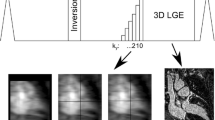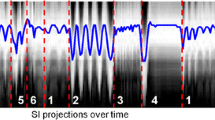Abstract
Navigator echo gating allows for the elimination of breath-holding in MR imaging by providing a real-time monitor of respiratory position to gate image acquisition. In this study we examined the advantages and utility of real-time, navigator echo gated slice following technique in 2D magnetic resonance coronary angiography of patients with coronary artery disease. Thirteen patients with coronary artery disease were examined. MR images of the right coronary artery (RCA) were obtained parallel to the atrioventricular groove to image long sections of the RCA in a small number of slices. In-plane resolution was 0.7 × 0.9 mm and 2–6 signals were averaged to support this high spatial resolution. Targeted maximum intensity projection (MIP) images were generated from the slices to present the RCA in a single image. All patients had x-ray angiograms available for comparison with the MR images. Using the navigator echo gated real-time slice following technique, MRI successfully obtained images in 11 of 13 cases. The technique failed in two patients with irregular breathing patterns. The average length of the RCA seen in the 11 successful MR exams was 61 mm and the average length seen in the x-ray angiograms was 80 mm. Eight patients were determined to be without disease in the RCA by x-ray angiography, and all eight were correctly identified as normal on the MRI exam. In the three patients who had a sucessful MRI exam and were determined to have disease in the RCA by x-ray angiography, MRI identified the lesion in two cases. In the third case MRI indicated a discrete lesion and x-ray angiography indicated diffuse disease without a focal lesion. Navigator echo gating improves patient tolerance, provides aligned sections of coronaries over multiple slices, and allows for improved resolution through signal averaging. This preliminary patient study suggests that navigator echo gated magnetic resonance coronary angiography may play a role in evaluating coronary artery disease.
Similar content being viewed by others
References
Manning WJ, Li W, Edelman RR, ‘A Preliminary Report Comparing Magnetic Resonance Coronary Angiography with Conventional Angiography’, N Engl J Med 1993; 328: 828-32.
Manning WJ, Li W, Boyle NG, Edelman RR, ‘Fat Supressed Breath-hold Magnetic Resonance Coronary Angiography’, Circulation 1993; 328: 828-32.
Pennel DJ, Keegan J, Firmin, DN, Gatehouse PD, Underwood SR, Longmore DB, ‘Magnetic Resonance Imaging of Coronary Arteries: Technique and Preliminary Results’, Br J Heart 1993; 70: 315-326.
Duerinckx AJ, Urman, ‘Two-dimensional Coronary MR Angiography: Analysis of Initial Clinical Results’, Radiology 1994; 193: 731-738.
Duerinckx AJ, Atkinson DP, Mintorovitch J, Simonetti O, Urman MK, ‘Two dimensional coronary MRA: limintation and artifacts’, European Radiology 1996; 6(5): 703.
Li D, Kaushkkar S, Haacke EM, Woodard PK, Dhawale PJ, Kroeker RM, Laub G, Kuginuki Y, Gutierrez FR, ‘Coronary Arteries: Three-dimensional MR Imaging with Retrospective Respiratory Gating’, Radiology 1993; 187: 401-406.
Li D, Pachal CB, Haacke EM, Adler LP, ‘Coronary Arteries: Three-dimensional MR Imaging with Fat Supression and Magnetization Transfer Contrast’, Radiology 1993; 187: 401-406.
Wang Y, Grist TM, Korosec FR, Christy PS, Alley MT, Polzin JA, Mistretta CA, ‘Respiratory motion blurring in 3D coronary imaging’, Mag Res Med 1995; 33: 541-548.
Oshinski JN, Hofland L, Mukundan S, Dixon WT, Parks WJ, Pettigrew RI, ‘Two-Dimensional MR Angiography of the Coronary Arteries without Breath-holding’, Radiology 1996; 201: 737-743.
Ehman RL, McNamara MT, Pallack M, Hricak H, Higgins CB, ‘Magnetic Resonance Imaging with Respiratory Gating: Techniques and Advantages’, AJR 1984; 143(6): 1175-82.
Runge VM, Clanton JA, Partain CL, James AE Jr, ‘Respiratory Gating inMagnetic Resonance Imaging at 0.5 Tesla’, Radiology, 1984; 151(2): 521-3.
Wang Y, Rossman PJ, Grimm RC, Riederer SJ, Ehman RL, ‘Navigator-based real-time respiratory gating and triggering for reduction of respiration effects in coronary MR imaging,’ Radiology 1996; 198: 55-60.
Ehman RL and Felmlee JP, ‘Adaptive Technique for High-definition MR Imaging of Moving Structures’, Radiology 1989; 173: 255-263.
Danias PG, McConnell MV, Khasgiwala VC, Chuang ML, Edelman RR, Manning WJ. ‘Prospective navigator correction of image position for coronary MR angiography’, Radiology 1997; 203(3): 733-736.
Edelman RR, Manning WJ, Pearlman J, Wei L, ‘Human Coronary Arteries: Projection Angiograms Reconstructed from Breath-hold Two-dimensional MR Images’, Radiology, 1991; 181: 641-643.
Oshinski JN, Pettigrew RI, and Ku DN, ‘Turbulent Fluctuation Velocity: The most Significant Determinate in Post-stenotic Signal Loss’, Mag Res Med 1995; 33: 193-199.
Sachs TS, Meyer CH, Irarrazabal P, Hu BS, Nishimura DG, Macovski A, ‘The Diminishing Variance Algorithm for Real-Time Reduction of Motion Artifacts in MRI’, Mag Res Med 1995; 34: 412-22.
Wang Y, Riederer SJ, Ehman RL, ‘Respiratory motion of the heart: kinematics and the implications for the spatial resolution in coronary imaging,’ Mag Res Med 1995; 33: 713-719.
Author information
Authors and Affiliations
Rights and permissions
About this article
Cite this article
Oshinski, J.N., Dixon, W.T. & Pettitgrew, R.I. Magnetic resonance coronary angiography using navigator echo gated real-time slice following. Int J Cardiovasc Imaging 14, 191–199 (1998). https://doi.org/10.1023/A:1006088727033
Issue Date:
DOI: https://doi.org/10.1023/A:1006088727033




